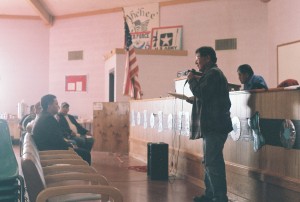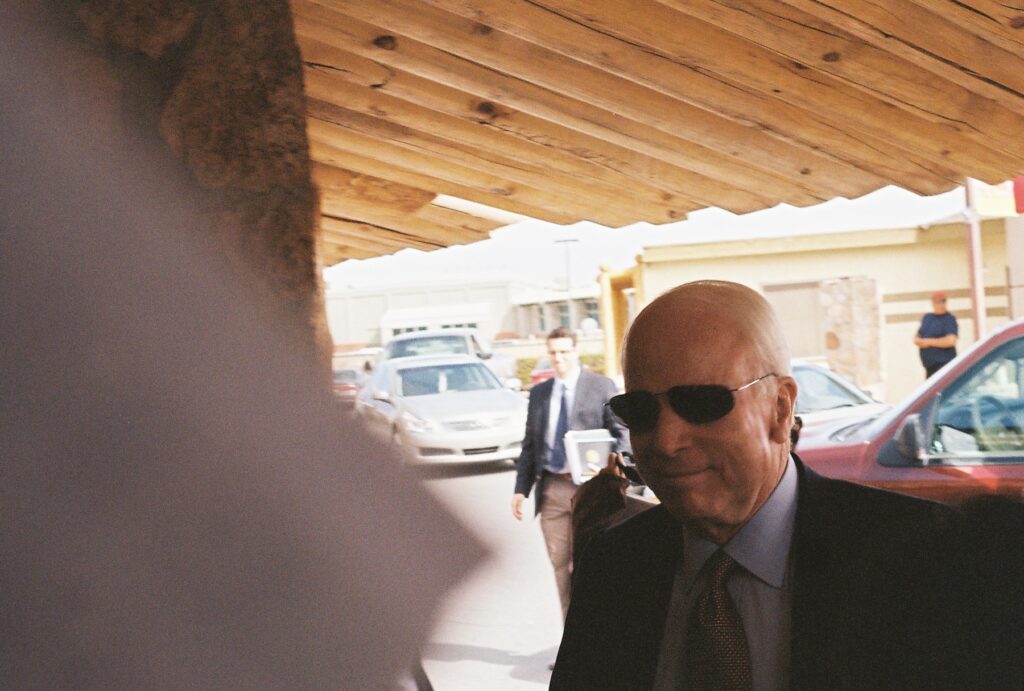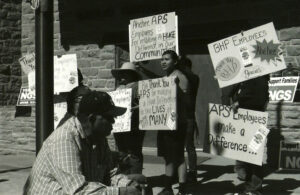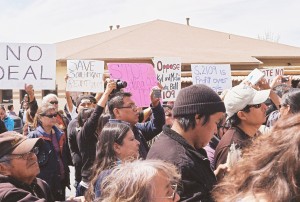Interivew: Andrew Curley and The Changing Nature of Navajo Tribal Sovereignty in an Era of Climate Change
Andrew Curley is a Ph.D. candidate in the Department of Development Sociology at Cornell University. In 2012 he received a Dissertation Fieldwork Grant to aid research on ‘The Changing Nature of Navajo Tribal Sovereignty in an Era of Climate Change,’ supervised by Dr. Wendy Wolford.
Briefly summarize the project that received Wenner-Gren funding.
The project I received funding for examined the attitudes of Navajo coal workers, environmentalists, and government officials about the future of the Navajo coal economy in this era of climate change. I entered the field site knowing that environmental regulation linked to process of climate change were on everyone’s minds, whether you supported coal or not. It was an inquiry to see what these attitudes suggest about the legacy and continued importance of the Navajo coal economy for the tribe and its people.
What initially drew you to this idea?
I initially became interested in the issue of coal in the Navajo Nation when I worked for a year as a research assistant at the Diné Policy Institute at Diné College in Tsaile, AZ. I had returned from a project I did in undergrad looking at fair trade labeling initiatives in Tanzania and Ghana and developed an appreciation at that time for how a single, exportable commodity like coffee, cocoa, or as I discovered in the case of the Navajo Nation–coal–could deeply embed itself into the politics and political system of a place. As I did work at a “policy” organization, which in actual fact was more of a hybrid between policy work, original research, and application of traditional concepts, I gained an appreciation for how prevalent coal was in the Navajo Nation. It was not that I wasn’t aware of the Navajo coal economy before this point. I was used to seeing draglines, hauling trucks, and most distinctly the monstrous power lines that crisscross across the reservation. It wasn’t a new fact so much as I gained a new appreciation for it when I stopped to consider the social movements who worked in many different ways to oppose coal development or propose alternative development projects in the place of coal. I think when I collaborated with my colleagues at the time on a report for the Speaker of the Navajo Nation Council about government reform, I tried to incorporate as much as I could the perspectives of members of environmental organizations who felt that the decisions of the Navajo tribal government didn’t reflect their thinking, their interest, or what they thought was the larger interest of the Navajo Nation.

It was a first crude attempt to think about what some might call civil society within tribal politics. I liked Michael Feher’s term “nongovernmental politics” at the time to describe people and groups who want to affect politics but “not govern,” or not seek formal political office. Thinking through the way members of Navajo environmental groups thought about development and politics revealed a lot about tribal governance in a larger sense. It wasn’t only me but anthropologist Dana Powell who was thinking through these questions at the time. This was late 2007, early 2008 when we worked together on a project to highlight some of these voices. We had similar but different projects at the time and we found there was room for collaboration. I left the Diné Policy Institute and went to graduate school in a sociology program to figure out a way to explain the persistence of the Navajo coal economy that I felt was not well understood or described at the time. I didn’t know what was missing but I felt that dialectical accounts of pro-coal development or anti-coal development missed some larger, structural condition. Again, reflecting on the research in fair trade, the particular commodity like “coffee” and the particular “crisis,” such as the “coffee crisis,” tells us very little about the people and places we often gloss over in description. This is the advantage of ethnography, the kind of research Wenner-Gren funds, it gets to the relational meaning of people, places and their politics (both formal and informal). I don’t think I could get the kind of perspective on coal I did without an embedded approach.
What preconceptions did you bring about coal to the field, and how did your work alter those views?
A preconception I had going in was that coal workers and large energy interests had the same agenda. It was kind of a silly assumption in retrospect. Anyone who thought about class conflict would have thought differently. But I don’t think there has been enough attention on questions of class and class stratification in reservation communities and this is in part a consequence of thinking of Native people as a homogenous group. In fact all political actors involved in questions of coal and development in the Navajo Nation will at one point or another try to speak on behalf of all Navajos, especially when talking about traditional understandings of things. But as I’ve learned through my research and the research of others, “tradition” is not simply contextual it is also actively political. It responds to the political questions at the time.
Another preconception I had was the idea of the environment and how Navajo people thought about the land and their resources. It’s not to say that I was totally mistaken on this. But I didn’t know to the extent that understanding of the land, water, even coal is fixed to anthropocentric ideas of survival and livelihood. This is probably true of coal workers and environmentalists, but especially for Navajo people the issues of nature and the environment and how to best appreciate these are linked to appeal to long-term survival. This is not always the case and in some instances a new ethic related to appreciating human impact on other species and larger environmental process, like the cycles of the planet impacted by climate change, has emerged.

Perhaps the largest surprise was the overwhelming question of water. In fact I approached the topic of coal and development largely unaware about how water looms large over it. But as I dug into the history and witnessed the popular rejection of a proposed water settlement between the Navajo Nation and the State of Arizona I realized that water is directly tied to coal. This also is not new. And in the case of the former Black Mesa Mine we know that the use of pristine aquifer water for over thirty years to slurry coal was a major motivation for many to challenge the industry. But this is not the water that looms large over coal, it’s the water of the Colorado River that does. So to put it more accurately, water doesn’t serve coal, coal serves water. I went to the field with a limited scope of the meanings of coal and development in the Navajo Nation. But digging into the history and immediate politics of the question, the need to power water from the Colorado River to central Arizona bore the most impact on the region and on the Navajo Nation. A professor in my department Phil McMichael coined a phrase “incorporated comparison” to think about how the development of one place impacts another. In this case, paraphrasing him and others who have used this method, you can’t understand the Navajo Nation today and its reliance on coal as a large source of jobs and revenue without knowing the history of the Central Arizona Project and efforts to bring water to Phoenix. They are integrally linked. I only realized this during my research.
Could you explain the Navajo concept of t’áá hwó ají t’éego and its relevance to coal? How did you first encounter it in the field?
There’s a lot to say about the meaning of t’áá hwó ají t’éego and although I’m Navajo, because I don’t speak the language fluently, I’ve had to rely on the way others have described its meaning to get a sense of what it means and importantly how it’s used to mean what it means. In fact in this sense I think not speaking Navajo fluently was an advantage because it has forced me to stop and ask many different people coming from different backgrounds their understanding of the phrase in order to put it into use in my analysis. If I were a fluent speaker I might just give you my meaning of it and not represent its variegated meaning, which I am trying to do in the process of writing my dissertation right now actually. In short, it means, “Do it yourself,” or you are responsible for accomplishing what you want and or need to get done. It’s a historical concept with contemporary meaning. I argue that it’s rooted in subsistence logic, when Navajo people lived under harsher conditions and had to provide for family and ourselves with the resources around us. It’s important to remember that the climate and landscape for the reservation varies from place to place, so Navajo people had to be resourceful and adaptive. We also developed much of this resourcefulness while surrounded by enemies, from Spanish colonialists to today’s border town communities like Farmington and Flagstaff. The concept is rooted in this history of self-sufficiency and survival and continues to carry these meanings. It’s just understood to work in different circumstances today. For many Navajo coal workers, survival and self-sufficiency is working on a dragline, or driving a truck used for hauling, or working as an electrician at the mine. We might disagree with the work for environmental reasons, but we have to respect the work as meaningful for those who participate in it. They see it as providing for the family, paying for their children’s education, or helping out relatives who don’t have work in live under hardship.

I encountered the phrase interviewing a coal worker who used it to describe his motivation for work. It wasn’t something scripted and fed to me, it came out almost accidentally as he pleaded for me to understand why this work was important for him and others at the mine. He only used the phrase once and it was used in service to a longer, more detailed explanation as to why coal work was important to him. It was almost like happenstance, he just blurted out “like our grand parents told us, t’áá hwó ají t’éego or you have to do it yourself,” paraphrasing here, but this is the gist of what he said.
What were some challenges or difficulties that arose during the course of fieldwork? How did you adapt?
I think the greatest challenge was getting anyone to trust me. It was a politically sensitive project. I have family who participate in politics and take certain stances on issues. At times I agree with them. I think some didn’t know if I would disagree with them on how they thought about the issue, or if I would use the material in a way to discredit their work. I could understand their concern even if it frustrated me at times. There are people who write about this same topic and who clearly take a position that supports one group’s arguments over the other’s. I don’t want to insinuate that research should be apolitical or anything like that. But it did cause me difficulty throughout the project. Especially when I moved to Kayenta, Arizona—perhaps the Navajo community most in support of continued coalmining in the reservation. There I was outsider. I didn’t have family or really know anyone from there. When I asked questions publicly like, “should the Navajo Nation extend the lease of the Navajo Generating Station,” the main power plant that purchased Navajo coal and was negotiating a lease extension with that Navajo Nation at the time, some interpreted this question as threatening. I had one coal worker refuse to fill out the survey. But he told me he was a member of the union and took a copy of my survey with him that he said he would show to company officials. Another informant told me that a non-Native reporter from the State of Washington visited the town the year before I arrived, did they same kind of interviewing, but wrote a largely critical piece on the Navajo coal economy that he interpreted as a betrayal of sorts. Now, how do you manage a situation like that?

You ask people to spare their time and let you know how they think about issues related to coalmining, a politically divisive issue. But you are expected to write something positive or lose their trust. I told them what my study was about and tried to say that it wasn’t a simply pro-coal or anti-coal report. It was to understand the complexity of the question and the issue. On the other hand, I don’t think members of the Navajo environmental community trusted my research completely because I based a substantial amount of it talking to coal workers. To put it simply, each side’s face scowled when I told them I was interviewing people on the other side of the issue. Now, someone who has a lot of experience in journalism in the area told me, in the context of newswriting, that angering opposite sides of an issue for different reasons doesn’t mean that you got the right story. I think there is some truth to this for sure. On the other hand I think it’s inevitable that people won’t like a story that doesn’t conform to frameworks they have long established and put into practice. So if my point is to move out of these frameworks, I think it’s hard not to write anything that wouldn’t be satisfying for the informants. This is probably the single longest shadow that hangs over anthropology, writing about people in a way that they don’t agree with. At first it was done brazenly, but now much more sensitively and subtlety, but maybe it’s still not right. Perhaps the concerns my informants had about my project were concerns that can be directed at most ethnographers (or journalists for that matter).
I tried to overcome it through honesty and openness. This is what “science” requires: transparency, logic and rigor to methods, but probably most importantly honesty and openness to new approaches and understandings of the situation. I had to get permission from community members who participated in the local chapter house to do my research. I had to tell them what my project was about. I had to tell my informants how they controlled the data they were about to provide. As I listen to the audio recordings now I can hear how people wanted me to skip over it and just get into asking them questions. But it’s important to let them know the difference between a research project like the one I conducted and other kinds of interview they might give. We will see how well I did when I finish the dissertation. I plan to go back to Arizona and present my findings to members of the community. I am sure at that time people will both agree with me on some points but also disagree with me on others. I am looking forward to getting this feedback.
What’s next for this project? How could you see it expanding or continuing?
I would like to further develop this concept and relate it to some economic anthropology and economic surveys done in the region. That would be the immediate follow up to the project. It would be cool if I could do something with Navajo students in the region. I would like to help develop research in these communities. Obviously I think I would work in the Navajo Nation, but it might be illustrative of these issues to do similar projects in other reservations. The tension between minerals, development, the environment, and livelihood exists in many different tribal reservations. It speaks to the particular legal predicament tribes face within ongoing settler-colonialism that is largely indifferent to indigenous concerns. To build capacity we need to know and solve our own problems. We also need to renew internal intellectual interest in these issues. I think the tribal colleges are a good starting point. Regional universities could do more to connect Native students with research in their communities. I have to first finish this analysis and figure out what might be the best follow up steps to it.